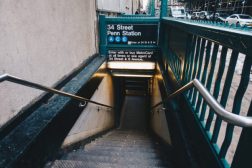Piece by piece, next generation 911 is coming

One of the nation’s most critical systems — 911 — has been a technological laggard for years. That’s finally starting to change, as companies like Apple and Google stir public interest in new features like the ability to share more precise location data with emergency responders. But for infrastructure that has in many places gone untouched for decades and has no clear source of funding for upgrades, the path leading to the next generation of 911 is unclear.
But work is being done nonetheless — some counties and even entire states have been upgrading to next generation 911 for years. The technology surfaces in the news regularly, usually via regional funding announcements. Earlier this month, local media heralded a $1 million project to build a next generation 911 system in Lewis County, Washington, a region with a population of about 75,000 people south of Olympia. The system promises to be faster and more resilient, with better location accuracy and the ability for callers to contact emergency services with photos, video and text.
Announcements like Lewis County’s are only small parts of a national crawl toward a new emergency-response communications infrastructure, however, given that there are about 6,500 public safety answering points, or PSAPs, across the U.S.
As that slow movement continues, the complexity of today’s wireless infrastructure means a single 911 call can briefly bounce around a handful of facilities before it’s answered. With lives at stake, spotty coverage for next generation 911, therefore, won’t be considered acceptable by emergency managers. And for many, the technology is now beginning to appear too promising to pass up.
Location, location
Next generation 911 isn’t here yet — no one is using smartphone cameras to show 911 call-takers what’s happening at the scene of an emergency. And call centers don’t have the systems in place to pass that data around to their neighboring call centers.
But various upgrades have been underway for years, so there must be some next generation 911, somewhere, right? In the words of Brian Fontes, CEO of the National Emergency Number Association, or NENA, “It’s not a clean yes or no — it’s not a light-switch answer.”
Some jurisdictions say they have the capability for next generation 911 but that they’re just not using it yet. Many more have yet to begin upgrading. Counties in several states, including Indiana, Maine, Texas, California and Tennessee, have achieved or are working toward NENA’s architecture standards . One jurisdiction — Fayette County, Georgia — has plans to launch what it’s claiming as the first next generation 911 system in the U.S. this fall, but even looking at a single county isn’t going to provide a definitive answer about the official dawn of the technology, Fontes says — there are a lot of moving pieces.
Beyond the components that will allow people to send photos and videos to dispatchers, Fontes says, there are also a lot of other elements that make a system “next generation,” including the backend systems that would allow PSAPs to relay that digital information to and from one another and back to the caller. It’s a technical challenge made more difficult by the fact that 911 was designed with the assumption that the caller’s location was — and always would be — fixed to the line being used to make an analog call.
The ability to receive and manage accurate cell location data is critical for 911 centers, particularly given that 80 percent of the 911 calls today are made from cell phones, according to NENA. The FCC is trying to improve location accuracy by putting new location precision requirements on cell carriers each year. Last year, the requirement was that carriers provide location data within 50 meters, 40 percent of the time. In 2018, the requirement is 50 meters, 50 percent of the time. And those requirements will continue to ramp up, but the cell-based location data that will be integrated into next generation 911 is far more accurate.
Apple announced a new partnership this month with RapidSOS , a company backed by three former FCC officials that aims to provide an alternative and more precise channel for location data than what’s currently available via cell tower triangulation. Apple plans to include the feature in its release of iOS 12 later this year.
When Google tested the technology last year with partners RapidSOS and West Corp., it found cell-based location data was more precise and delivered more quickly. Instead of average carrier location precision of 522 feet, the cell-delivered location averaged 121 feet within the caller’s location. As indoor-location technology improves, that circle is expected to shrink even further.
West Corp. also found that the more precise location was delivered earlier in the call 34 percent of the time, often in less than five seconds. By the FCC’s estimation, shaving just one minute off emergency response time correlates with 10,000 lives saved annually.
RapidSOS has also partnered with Uber and Waze to further penetrate the mobile market. But all of the advancements on the device-side of a call have their limitations. If a 911 call center isn’t equipped to handle such data, it’s effectively worthless at that site and less than half of PSAPs today are equipped for it.
Dave Sehnert, director of innovation and integration for Mission Critical Partners, a consulting and lifecycle management firm specializing in public safety systems, said his company tested carriers in rural areas of the U.S. last year and found they were all meeting the FCC’s location precision requirements, but expects technologies like those offered by RapidSOS will provide a valuable supplement as demand for service quality in emergency response catches up to the convenience and accuracy that consumers expect elsewhere in their digital environments.
“That’s where you have a lot of excitement in the industry — to have better location, faster,” he said.
Emergency fusion
Precise location data alone isn’t next generation 911. Another integral component is the ability to handle new streams of data and then deploy the new capabilities that they make possible.
This month, Mission Critical Partners announced a new program designed to help PSAPs integrate all the data that is expected to start coming their way as they move toward next generation 911. Beyond the immediate expectations of delivering video, photos and improved location data, Sehnert says jurisdictions are looking at integration with existing infrastructure — like with street-level “smart city” sensors and city- or state Department of Transportation-owned video cameras. Analytics gathered via 911 operations could also someday be used by other government agencies — if a certain intersection, freeway on-ramp, or railroad crossing is generating lots of 911 calls, that could give the transportation department a clue of where it should be focusing its attention.
Given all the new streams of data coming in, the PSAP of the future could look something like a hybrid between today’s 911 call center and a fusion center, Sehnert said.
“911 centers as they are today in some regions may continue to operate as they have,” Sehnert said, “but they may need a support center that would be looking at more rich data sets and would potentially a distraction from 911 operations that they need to have the eyes on the information such as video or sensors and then integrate with PSAP operations when it’s appropriate.”
Social media is a prime example of a new data stream that can help emergency responders, but that is potentially distracting. Officials in Charleston County, South Carolina, a jurisdiction Mission Critical Partners has entered a pilot project with, are considering overcoming that challenge, Sehnert said, by creating new positions in the 911 center that sit between call takers and dispatch, dedicated to managing those supplemental data streams.
The county is seeking continuity of 911 operations as it balances technologies from the Leave It to Beaver era with those of the Twitter age.
Opening the floodgates
911 call centers have been conservative in their adoption of new technologies because any disruption of service could potentially lead to loss of life. But some jurisdictions are beginning to see that if only they’re willing to weather the upgrade, superlative benefits await them.
Fayette County, Georgia, with a population of about 110,000, is slated to be the first in the nation to launch a “true” next generation 911 call center, its vendor says, in early September. The Atlanta-area county’s vendor, Carbyne , also has pilots in Mexico and Israel, and is now starting to enter Europe and the U.S. Amir Elichai, Carbyne’s founder, told StateScoop that getting U.S. customers to buy in to the new generation of technology has been a challenge.
Elichai said he’s in talks with other counties in New Jersey, Georgia, New York and Indiana, but everyone’s waiting to see how things go in Fayette County first. Carbyne offers a complete, plug-and-play next generation 911 solution, but it doesn’t handle any of the integration challenges — they simply provide the system. But since Bernard Brown, director of the county’s 911 communications center saw the technology being tested in a pilot in his county from August to December last year, he’s been converted into a believer.
“I’m willing to take this chance because I’m sold on this product,” Brown said. “I’ve been in this industry for 34 years and I’ve seen a lot of changes and this is something that I think is going to reduce call-handling time, it’s going to save lives, it’s going to pinpoint locations for people, I could just go on and on and on. I think once people see us go live here in Fayette County and they see what it does, they’re going to be looking to get in line and jump on board. The floodgates will open after we go live.”
In March, county commissioners approved $192,000 in spending for the first year of the program, and subsequent years are expected to come at the same annual cost. This relatively low funding level was made possible through deep discounts — between 33 and 50 percent annually — offered by the vendor. But not everyone is going to get a discount. Funding, especially for a system that needs consistency across PSAP jurisdictions to be effective, will be a major challenge for the nation in the coming years.
The Middle Class Tax Relief and Job Creation Act of 2012, the same law that created FirstNet , a wireless data network for first responders built by AT&T and supported by tens of billions of dollars in public and private funding, also provided $115 million for next generation 911 upgrades. It also called for a study that looks at the cost of a national transition to next generation 911. Fontes said that report has been sitting in the Office of Management and Budget for several months, unreleased, but rumor has it that the figure for a national next generation 911 rollout is estimated between $8 billion and $13 billion.
Jurisdictions have financial mechanisms in place to support 911 that usually come in the form of fees placed on phone bills, but those those funds are often steered elsewhere — and it wouldn’t be enough to cover the billions thought needed for a nationwide upgrade, anyway. Today, it’s every PSAP for itself.
For now, the individual pieces of technology that would allow a trapped student to stream to law enforcement the scene of a school shooting are available, but 911 hasn’t put them all together yet. Everyone knows 911 is important, Fontes says, but the people and centers that keep it going have, to the public’s detriment, become the “unsung heroes” of the public safety world.
“We’re the victim of our own success,” Fontes said. “People just expect it to work without even thinking about how it works or the quality of technology and training inside those 911 centers.”




